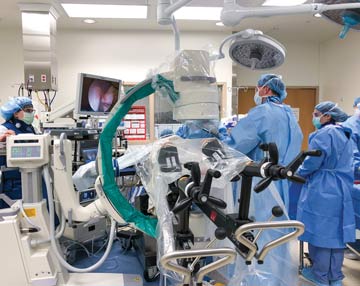Intraoperative fluoroscopy is a powerful but potentially dangerous aspect of many surgeries. The goal is to get the exact images the surgeon needs without exposing everyone in the room to harmful radiation. It seems like a simple enough concept, but in some cases what the surgeon wants in terms of operating or positioning the C-arm is not what the radiology technologist is hearing. As a result, the image is unsuitable, members of the surgical team are unnecessarily exposed and, from an operational standpoint, precious time is wasted.
Communication problems between surgeons and radiologic techs are by no means universal — especially in outpatient centers where surgeons and techs often know each other's tendencies and verbiage well and work with each other regularly — but it can be an issue.
Seth Yarboro, MD, an associate professor of orthopedic surgery at the University of Virginia in Charlottesville, was experiencing occasional C-arm communication problems during surgery. "It wasn't one specific incident, but the variability of different experiences," he says. "Some-times you'd have a technologist in the room who knew all the steps of the case, and you barely needed to talk. Other times somebody who had a little less experience needed to be told how to get the appropriate fluoroscopy shots to proceed with the case safely and effectively."
Dr. Yarboro coauthored a paper published in the Journal of the American Academy of Orthopaedic Surgeons (osmag.net/3xKI5BJ) that outlines a standardized language surgeons and techs can use to communicate effectively during surgery. "There are typical movements the C-arm needs to accomplish during most surgeries across different specialties," says Dr. Yarboro.
He brought surgeons and radiologic techs together to negotiate common terminology that worked for the facility. "'Roll' is the one that comes up a lot — roll the C-arm forward and roll it back," he says. "We probably had three or four different terms that were considered for that. It really helped to agree on a term and use it consistently moving forward."
Once the common language was agreed upon, short training sessions were held, and later in the project, follow-up meetings allowed everyone to review the language's effectiveness and implementation. Dr. Yarboro saw a need to reinforce the protocol with retraining.
He laminated the protocol and attached it to all of the fluoroscopy displays. "Everybody's aware we've got the protocol in place, and you can revert back to it in those times when maybe it's a little more challenging to communicate exactly what we're trying to accomplish," he says.
.svg?sfvrsn=be606e78_3)

.svg?sfvrsn=56b2f850_5)